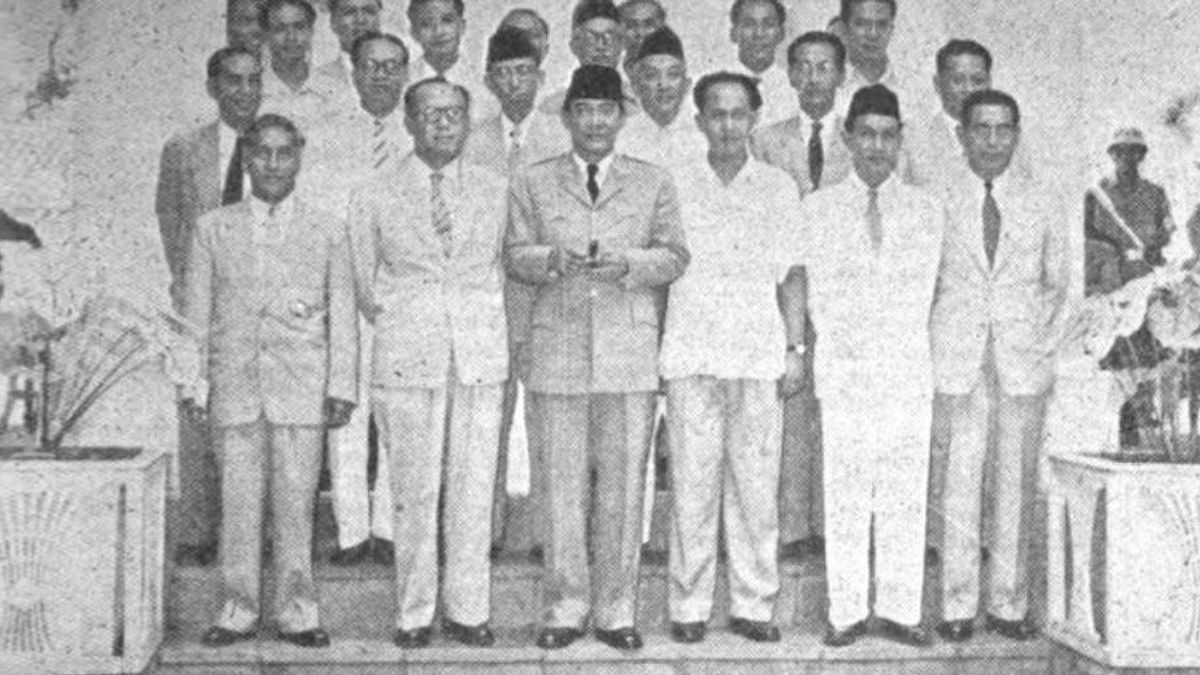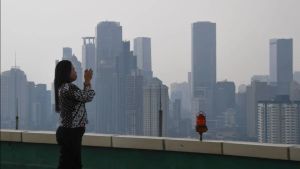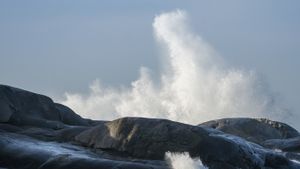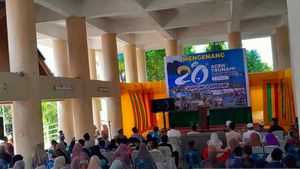JAKARTA - The Karya Cabinet or Djuanda was actually Sukarno's national consolidation effort. The way the First President of the Republic of Indonesia reunited the nation's division. He seemed to be trying to suppress the "political ego" of each group in creating this non-party cabinet. to the point of creating a common enemy: the Dutch imperialism.
Before the cabinet of works or Djuanda was formed, the Republic of Indonesia was being divided. The proof is, as explained by Febta Pratama Aman in the Yogyakarta State University social science journal entitled "Indonesian Foreign Policy Policy in the Djuanda Cabinet Period 1957-1959" (2013), the dissolution of the cabinet before Djuanda, namely the Ali Sastroamijoyo Cabinet, was due to divisions, both inside and outside. outside the cabinet.
Within the cabinet itself, divisions could be seen from the number of ministers who were drawn by the supporting party. For example Masyumi who withdrew his minister from the cabinet chair Ali Sastroamijoyo. One reason was that they were reluctant to collaborate with the PKI.
Outside the government, divisions escalated with the emergence of regional rebellion movements. This rebellion arose because of their dissatisfaction with the policies of the central government.
Things got worse in 1956. At that time, Vice President Mohammad Hatta resigned from his position. There is no more Dwitunggal. His resignation resulted in a loss of public confidence in the central government. Support from the two parties supporting Hatta, PSI and Masyumi had the potential to become lax against the government at that time.
In the same year, an idea emerged from the President regarding the conception of the President. The idea was only announced on February 21, 1957. One of the most controversial was the idea of guided democracy which replaced the previous system, namely parliamentary democracy.
Instead of solving the problem, this conception makes things even more complicated. The problem is that there are not a few who oppose this guided democracy.
The amount of pressure from both internal cabinet issues and regional rebellion problems made Ali Sastroamijoyo return the mandate to President Sukarno.
Suppressing the Party Ego
It is difficult to form a new cabinet after Ali Sastroamijoyo's cabinet disbanded. Sukarno twice appointed the Chairman of the PNI, Soewiryo, to form a new cabinet, but it always failed. Until finally Sukarno appointed himself as the formator.
National figures were gathered to formulate a new cabinet. Including the demisioner Ali Sastroamijoyo. Learning from previous experiences, Sukarno did not want this new cabinet to be founded on the basis of party interests.
Therefore Ali promoted people who were not from the party. Suddenly the name referred to Ir. Djuanda Kartawidjaja. He is a technocrat and capable of leading.
Finally on April 8, 1957 Sukarno announced a new cabinet at the Bogor Palace. He appointed Djuanda as the new Prime Minister. Djuanda is a figure respected and trusted by the wider community. Even the President did not hesitate to give him a double position as Minister of Defense in addition to the Prime Minister.
The cabinet which was later named the Zaken Cabinet or the Karya Cabinet was officially formed and was effective today 9 April 63 years ago or in 1957.
Djuanda is not alone in leading the cabinet. He was accompanied by Deputy Prime Minister I Mr. Hardi from PNI circles, and Deputy Prime Minister Dr. II. KH Idham Chalid from the Nahdliyin circle. Thus this cabinet is also called the Djuanda-Hardi-Idham Cabinet.
Although there are still ministers from the party, they cannot act on behalf of the party. The dissolution of the party which Sukarno dreamed of was manifested in this way. With this, the dignity of the political party leader is castrated. However, the existence of parties is maintained only as a display for the implementation of Guided Democracy.
The Karya Cabinet Program is also called Pancakarya because it has five objectives, including:
1. Establish a National Council
2. Normalization of the Condition of the Republic of Indonesia
3. Continue the KMB cancellation
4. Fight for West Irian
5. Accelerate Development
Creating a Common Enemy
Ahmad Mansyur Suryanegara in his book Api Historical Second Volume (2015) explains that the Pancakarya program is the answer to a national situation that is currently hit by conflict. "The country is experiencing divisions among political parties and the military," he wrote.
Therefore President Sukarno made serious efforts to divert internal problems. To do this, Sukarno raised awareness that his real opponents were not fellow children of the nation, but Dutch imperialists.
The anti-Dutch colonial revival movement immediately took shape. It started with holding the General Meeting of the Liberation of West Irian in Jakarta on 18 November 1957. On the same day the labor strike movement began to go hand in hand with the nationalization of the Dutch company.
The anti-Dutch movement also included the ban on all Dutch language films. The Dutch airline, KLM, is prohibited from landing at all airports in Indonesia.
In the world of education, anti-Dutch policies are also starting to be felt. The Department of History, Faculty of Letters, Padjadjaran University, led by R. Mohammad Ali, was dissolved by the Dean for maintaining the existence of Dutch Language as the Source Language of History.
Cannot Achieve Desired Yet
National consolidation efforts continue. One of the manifestations is by forming a national council. In May 1957 the Djuanda Government succeeded in forming a National Council chaired by President Sukarno himself. This council consists of functional groups, workers, peasants, businessmen and groups of military officers.
The National Council not only functions to assist and give authority to the cabinet, but also acts as a bridge between the community and the government.
As stipulated in the Emergency Law No. 7 1957 concerning the National Council, the task of this Council is to provide advice to the government on basic matters of state and society, either at the request of the government or on its own initiative, in order to smooth the running of the wheels of government and maintain political stability towards country development.
Meanwhile the regional upheaval continued and got stronger. The economic situation is getting more chaotic, due to the unstable political situation.
To overcome this situation, the National Council proposed holding a National Deliberation (Munas) as an effort to avoid national divisions and resolve conflicts between regions.
But unfortunately the National Conference which took place on 9-14 September 1957 in Jakarta had not yet created national harmony, because the regional representatives emphasized the problem of restoring the leadership of Dwitunggal Sukarno-Hatta. However, these efforts were in vain because the differences in views and attitudes between the two leaders had gone too far.
After failing at the National Conference, efforts are still ongoing with the holding of the National Development Conference (Munap). However, the Munap again ended with no meaning. The group that demanded that Hatta be returned to the government was not granted.
In fact, this has actually fueled the regional defiance of the peaks. The rebel commander in Sumatra and Sulawesi met with political leaders such as Natsir, Sjafruddin prawiranegara, and other figures in January 1958. They planned to form a new alternative Indonesian government. Sfajruddin was appointed as its Prime Minister.
They then demanded that the Djuanda cabinet be dissolved and form a national working cabinet that would work until the next election. However, the proposal was ignored. These rebels eventually formed the Revolutionary Government of the Republic of Indonesia (PRRI). However, Bung Hatta himself, the person they supported, did not approve of the formation of this government.
Basically, the basic contradiction that occurs in the Republic of Indonesia which is still in its infancy is the form of government and its system. The Hatta group in essence wanted a parliamentary form of government, while Sukarno wanted a presidential form with his guided democracy conception.
As a result, the debate on the ideological order continued until it had an impact on the tactical order, namely the emergence of existing rebellions.
Until the president issued a Decree on July 5, 1959, which would re-enforce the 1945 Constitution, automatically, the Djuanda Cabinet which stood on top of the 1950 Provisional Constitution automatically dissolved. The parliamentary democracy in effect since 1950 has been replaced by Sukarno's guided democracy system. Sukarno's goal had been achieved at the end of the Zaken Cabinet, but Indonesian national unity has a long story to tell. The alias did not materialize at that time.
The English, Chinese, Japanese, Arabic, and French versions are automatically generated by the AI. So there may still be inaccuracies in translating, please always see Indonesian as our main language. (system supported by DigitalSiber.id)










